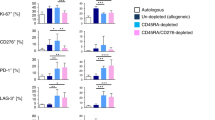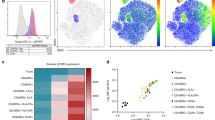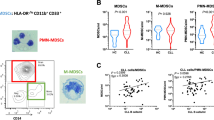Abstract
Myeloid-derived suppressor cells (MDSCs) have emerged as a heterogeneic immunoregulatory population that can expand in response to inflammatory signals. Predominantly studied in cancer, MDSCs suppress T cells utilizing various mechanisms. In allogeneic hematopoietic stem cell transplantation (allo-HSCT) therapy-related toxicity and alloreactivity increase inflammatory cytokines that might favor an MDSC accumulation. To address this question, circulating CD14+HLA-DRlow/neg cells were studied retrospectively in 51 allo-HSCT patients. These cells represent one of the few well-described human MDSC subsets under physiological and pathological conditions. The frequency of CD14+HLA-DRlow/neg cells was significantly increased after allo-HSCT, especially in patients with acute graft-versus-host disease. Compared to healthy donor cells they were pSTAT1low (phosphorylated signal transducer and activator of transcription) and indoleamine 2,3-dioxygenase (IDO)high. Serum levels of granulocyte colony-stimulating factor and interleukin-6, which both have been linked to MDSC induction, correlated positively with the frequency of CD14+HLA-DRlow/neg cells. In vitro dysfunction of patient T cells, such as reduced proliferative capacity or CD3ζ-chain expression, was rescued by blocking the IDO activity of CD14+HLA-DRlow/neg cells. Overall, we identified a T-cell-suppressive monocytic population that expands after allo-HSCT. The mechanisms responsible for such accumulation remain to be elucidated. It will be of great interest to prospectively investigate the influence of these cells on the graft-versus-tumor and -host reaction.
This is a preview of subscription content, access via your institution
Access options
Subscribe to this journal
Receive 12 print issues and online access
$259.00 per year
only $21.58 per issue
Buy this article
- Purchase on Springer Link
- Instant access to full article PDF
Prices may be subject to local taxes which are calculated during checkout





Similar content being viewed by others
References
Gabrilovich DI, Nagaraj S . Myeloid-derived suppressor cells as regulators of the immune system. Nat Rev Immunol 2009; 9: 162–174.
Cheron A, Floccard B, Allaouchiche B, Guignant C, Poitevin F, Malcus C et al. Lack of recovery in monocyte human leukocyte antigen-DR expression is independently associated with the development of sepsis after major trauma. Crit Care 2010; 14: R208.
Poschke I, Mougiakakos D, Hansson J, Masucci GV, Kiessling R . Immature immunosuppressive CD14+HLA-DR-/low cells in melanoma patients are Stat3hi and overexpress CD80, CD83, and DC-sign. Cancer Res 2010; 70: 4335–4345.
Ostrand-Rosenberg S, Sinha P . Myeloid-derived suppressor cells: linking inflammation and cancer. J Immunol 2009; 182: 4499–4506.
Marigo I, Bosio E, Solito S, Mesa C, Fernandez A, Dolcetti L et al. Tumor-induced tolerance and immune suppression depend on the C/EBPbeta transcription factor. Immunity 2010; 32: 790–802.
Lechner MG, Liebertz DJ, Epstein AL . Characterization of cytokine-induced myeloid-derived suppressor cells from normal human peripheral blood mononuclear cells. J Immunol 2010; 185: 2273–2284.
Lechner MG, Megiel C, Russell SM, Bingham B, Arger N, Woo T et al. Functional characterization of human Cd33+ and Cd11b+ myeloid-derived suppressor cell subsets induced from peripheral blood mononuclear cells co-cultured with a diverse set of human tumor cell lines. J Transl Med 2011; 9: 90.
Filipazzi P, Huber V, Rivoltini L . Phenotype, function and clinical implications of myeloid-derived suppressor cells in cancer patients. Cancer Immunol Immunother 2012; 61: 255–263.
Peranzoni E, Zilio S, Marigo I, Dolcetti L, Zanovello P, Mandruzzato S et al. Myeloid-derived suppressor cell heterogeneity and subset definition. Curr Opin Immunol 2010; 22: 238–244.
Kusmartsev S, Su Z, Heiser A, Dannull J, Eruslanov E, Kubler H et al. Reversal of myeloid cell-mediated immunosuppression in patients with metastatic renal cell carcinoma. Clin Cancer Res 2008; 14: 8270–8278.
Corzo CA, Cotter MJ, Cheng P, Cheng F, Kusmartsev S, Sotomayor E et al. Mechanism regulating reactive oxygen species in tumor-induced myeloid-derived suppressor cells. J Immunol 2009; 182: 5693–5701.
Hoechst B, Ormandy LA, Ballmaier M, Lehner F, Kruger C, Manns MP et al. A new population of myeloid-derived suppressor cells in hepatocellular carcinoma patients induces CD4(+)CD25(+)Foxp3(+) T cells. Gastroenterology 2008; 135: 234–243.
Loercher AE, Nash MA, Kavanagh JJ, Platsoucas CD, Freedman RS . Identification of an IL-10-producing HLA-DR-negative monocyte subset in the malignant ascites of patients with ovarian carcinoma that inhibits cytokine protein expression and proliferation of autologous T cells. J Immunol 1999; 163: 6251–6260.
MacDonald KP, Rowe V, Clouston AD, Welply JK, Kuns RD, Ferrara JL et al. Cytokine expanded myeloid precursors function as regulatory antigen-presenting cells and promote tolerance through IL-10-producing regulatory T cells. J Immunol 2005; 174: 1841–1850.
Srivastava MK, Sinha P, Clements VK, Rodriguez P, Ostrand-Rosenberg S . Myeloid-derived suppressor cells inhibit T-cell activation by depleting cystine and cysteine. Cancer Res 70: 68–77.
Vuk-Pavlovic S, Bulur PA, Lin Y, Qin R, Szumlanski CL, Zhao X et al. Immunosuppressive CD14+HLA-DRlow/- monocytes in prostate cancer. Prostate 2010; 70: 443–455.
Lin Y, Gustafson MP, Bulur PA, Gastineau DA, Witzig TE, Dietz AB . Immunosuppressive CD14+HLA-DR(low)/- monocytes in B-cell non-Hodgkin lymphoma. Blood 2011; 117: 872–881.
Hoechst B, Gamrekelashvili J, Manns MP, Greten TF, Korangy F . Plasticity of human Th17 cells and iTregs is orchestrated by different subsets of myeloid cells. Blood 2011; 117: 6532–6541.
Luyckx A, Schouppe E, Rutgeerts O, Lenaerts C, Koks C, Fevery S et al. Subset characterization of myeloid-derived suppressor cells arising during induction of BM chimerism in mice. Bone Marrow Transplant 2012; 47: 985–992.
Ghansah T, Paraiso KH, Highfill S, Desponts C, May S, McIntosh JK et al. Expansion of myeloid suppressor cells in SHIP-deficient mice represses allogeneic T cell responses. J Immunol 2004; 173: 7324–7330.
Highfill SL, Rodriguez PC, Zhou Q, Goetz CA, Koehn BH, Veenstra R et al. Bone marrow myeloid-derived suppressor cells (MDSCs) inhibit graft-versus-host disease (GVHD) via an arginase-1-dependent mechanism that is up-regulated by interleukin-13. Blood 2010; 116: 5738–5747.
Seggewiss R, Einsele H . Immune reconstitution after allogeneic transplantation and expanding options for immunomodulation: an update. Blood 2010; 115: 3861–3868.
Solito S, Falisi E, Diaz-Montero CM, Doni A, Pinton L, Rosato A et al. A human promyelocytic-like population is responsible for the immune suppression mediated by myeloid-derived suppressor cells. Blood 118: 2254–2265.
Landfried K, Zhu W, Waldhier MC, Schulz U, Ammer J, Holler B et al. Tryptophan catabolism is associated with acute GVHD after human allogeneic stem cell transplantation and indicates activation of indoleamine 2,3-dioxygenase. Blood 2011; 118: 6971–6974.
Hainz U, Obexer P, Winkler C, Sedlmayr P, Takikawa O, Greinix H et al. Monocyte-mediated T-cell suppression and augmented monocyte tryptophan catabolism after human hematopoietic stem-cell transplantation. Blood 2005; 105: 4127–4134.
Mattsson J, Uzunel M, Tammik L, Aschan J, Ringden O . Leukemia lineage-specific chimerism analysis is a sensitive predictor of relapse in patients with acute myeloid leukemia and myelodysplastic syndrome after allogeneic stem cell transplantation. Leukemia 2001; 15: 1976–1985.
Yang R, Cai Z, Zhang Y, WHt Yutzy, Roby KF, Roden RB . CD80 in immune suppression by mouse ovarian carcinoma-associated Gr-1+CD11b+ myeloid cells. Cancer Res 2006; 66: 6807–6815.
Pan PY, Ma G, Weber KJ, Ozao-Choy J, Wang G, Yin B et al. Immune stimulatory receptor CD40 is required for T-cell suppression and T regulatory cell activation mediated by myeloid-derived suppressor cells in cancer. Cancer Res 2010; 70: 99–108.
Lob S, Konigsrainer A, Rammensee HG, Opelz G, Terness P . Inhibitors of indoleamine-2,3-dioxygenase for cancer therapy: can we see the wood for the trees? Nat Rev Cancer 2009; 9: 445–452.
Rodriguez PC, Ernstoff MS, Hernandez C, Atkins M, Zabaleta J, Sierra R et al. Arginase I-producing myeloid-derived suppressor cells in renal cell carcinoma are a subpopulation of activated granulocytes. Cancer Res 2009; 69: 1553–1560.
Youn JI, Nagaraj S, Collazo M, Gabrilovich DI . Subsets of myeloid-derived suppressor cells in tumor-bearing mice. J Immunol 2008; 181: 5791–5802.
De Wilde V, Van Rompaey N, Hill M, Lebrun JF, Lemaitre P, Lhomme F et al. Endotoxin-induced myeloid-derived suppressor cells inhibit alloimmune responses via heme oxygenase-1. Am J Transplant 2009; 9: 2034–2047.
Mougiakakos D, Jitschin R, Johansson CC, Okita R, Kiessling R, Le Blanc K . The impact of inflammatory licensing on heme oxygenase-1-mediated induction of regulatory T cells by human mesenchymal stem cells. Blood 2011; 117: 4826–4835.
Kusmartsev S, Gabrilovich DI . STAT1 signaling regulates tumor-associated macrophage-mediated T cell deletion. J Immunol 2005; 174: 4880–4891.
Bronte V, Serafini P, De Santo C, Marigo I, Tosello V, Mazzoni A et al. IL-4-induced arginase 1 suppresses alloreactive T cells in tumor-bearing mice. J Immunol 2003; 170: 270–278.
Chakraverty R, Cote D, Buchli J, Cotter P, Hsu R, Zhao G et al. An inflammatory checkpoint regulates recruitment of graft-versus-host reactive T cells to peripheral tissues. J Exp Med 2006; 203: 2021–2031.
Bharadwaj U, Li M, Zhang R, Chen C, Yao Q . Elevated interleukin-6 and G-CSF in human pancreatic cancer cell conditioned medium suppress dendritic cell differentiation and activation. Cancer Res 2007; 67: 5479–5488.
Mougiakakos D, Choudhury A, Lladser A, Kiessling R, Johansson CC . Regulatory T cells in cancer. Adv Cancer Res 2010; 107: 57–117.
Sinha P, Clements VK, Bunt SK, Albelda SM, Ostrand-Rosenberg S . Cross-talk between myeloid-derived suppressor cells and macrophages subverts tumor immunity toward a type 2 response. J Immunol 2007; 179: 977–983.
Thibodeau J, Bourgeois-Daigneault MC, Huppe G, Tremblay J, Aumont A, Houde M et al. Interleukin-10-induced MARCH1 mediates intracellular sequestration of MHC class II in monocytes. Eur J Immunol 2008; 38: 1225–1230.
Cuenca AG, Delano MJ, Kelly-Scumpia KM, Moreno C, Scumpia PO, Laface DM et al. A paradoxical role for myeloid-derived suppressor cells in sepsis and trauma. Mol Med 2011; 17: 281–292.
Mielcarek M, Martin PJ, Torok-Storb B . Suppression of alloantigen-induced T-cell proliferation by CD14+ cells derived from granulocyte colony-stimulating factor-mobilized peripheral blood mononuclear cells. Blood 1997; 89: 1629–1634.
Cheng P, Corzo CA, Luetteke N, Yu B, Nagaraj S, Bui MM et al. Inhibition of dendritic cell differentiation and accumulation of myeloid-derived suppressor cells in cancer is regulated by S100A9 protein. J Exp Med 2008; 205: 2235–2249.
Obermajer N, Muthuswamy R, Lesnock J, Edwards RP, Kalinski P . Positive feedback between PGE2 and COX2 redirects the differentiation of human dendritic cells toward stable myeloid-derived suppressor cells. Blood 2011; 118: 5498–5505.
Banovic T, Markey KA, Kuns RD, Olver SD, Raffelt NC, Don AL et al. Graft-versus-host disease prevents the maturation of plasmacytoid dendritic cells. J Immunol 2009; 182: 912–920.
Von Bubnoff D, Scheler M, Wilms H, Fimmers R, Bieber T . Identification of IDO-positive and IDO-negative human dendritic cells after activation by various proinflammatory stimuli. J Immunol 2011; 186: 6701–6709.
Joo YD, Lee SM, Lee SW, Lee WS, Park JK, Choi IW et al. Granulocyte colony-stimulating factor-induced immature myeloid cells inhibit acute graft-versus-host disease lethality through an indoleamine dioxygenase-independent mechanism. Immunology 2009; 128 (Suppl): e632–e640.
Lin MT, Tseng LH, Frangoul H, Gooley T, Pei J, Barsoukov A et al. Increased apoptosis of peripheral blood T cells following allogeneic hematopoietic cell transplantation. Blood 2000; 95: 3832–3839.
Nausch N, Galani IE, Schlecker E, Cerwenka A . Mononuclear myeloid-derived ‘suppressor’ cells express RAE-1 and activate natural killer cells. Blood 2008; 112: 4080–4089.
Apolloni E, Bronte V, Mazzoni A, Serafini P, Cabrelle A, Segal DM et al. Immortalized myeloid suppressor cells trigger apoptosis in antigen-activated T lymphocytes. J Immunol 2000; 165: 6723–6730.
Meisel R, Brockers S, Heseler K, Degistirici O, Bulle H, Woite C et al. Human but not murine multipotent mesenchymal stromal cells exhibit broad-spectrum antimicrobial effector function mediated by indoleamine 2,3-dioxygenase. Leukemia 2011; 25: 648–654.
Varga G, Ehrchen J, Tsianakas A, Tenbrock K, Rattenholl A, Seeliger S et al. Glucocorticoids induce an activated, anti-inflammatory monocyte subset in mice that resembles myeloid-derived suppressor cells. J Leukoc Biol 2008; 84: 644–650.
Acknowledgements
KLB was supported by grants from the Swedish Cancer Foundation (110315), the Children’s Cancer Foundation (08/071), the Swedish Research Council (K2011-??X-20742–04–6), the Tobias Foundation, VINNOVA (2010–00501), the Stockholm City Council (ALF 20110152) and the Cancer Society in Stockholm. DM was supported by the German Research Association (DFG), the Interdisciplinary Center of Clinical Research (IZKF) Erlangen and the University of Erlangen-Nuremberg (ELAN grant).
Author information
Authors and Affiliations
Corresponding author
Ethics declarations
Competing interests
The authors declare no conflict of interest.
Additional information
Supplementary Information accompanies the paper on the Leukemia website
Supplementary information
Rights and permissions
About this article
Cite this article
Mougiakakos, D., Jitschin, R., von Bahr, L. et al. Immunosuppressive CD14+HLA-DRlow/neg IDO+ myeloid cells in patients following allogeneic hematopoietic stem cell transplantation. Leukemia 27, 377–388 (2013). https://doi.org/10.1038/leu.2012.215
Received:
Revised:
Accepted:
Published:
Issue Date:
DOI: https://doi.org/10.1038/leu.2012.215
Keywords
This article is cited by
-
The functional and molecular impact of triamcinolone acetonide on primary human bone marrow mesenchymal stem cells
Scientific Reports (2023)
-
Coordinated regulation of immune contexture: crosstalk between STAT3 and immune cells during breast cancer progression
Cell Communication and Signaling (2021)
-
Myeloid-derived suppressor cells in hematological malignancies: friends or foes
Journal of Hematology & Oncology (2019)
-
Early myeloid-derived suppressor cells (HLA-DR−/lowCD33+CD16−) expanded by granulocyte colony-stimulating factor prevent acute graft-versus-host disease (GVHD) in humanized mouse and might contribute to lower GVHD in patients post allo-HSCT
Journal of Hematology & Oncology (2019)
-
CD33/CD3-bispecific T-cell engaging (BiTE®) antibody construct targets monocytic AML myeloid-derived suppressor cells
Journal for ImmunoTherapy of Cancer (2018)



